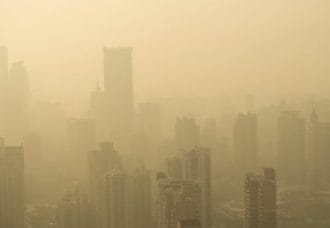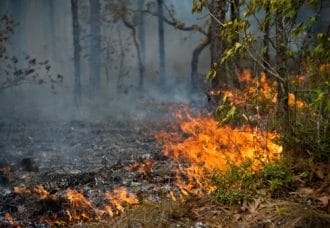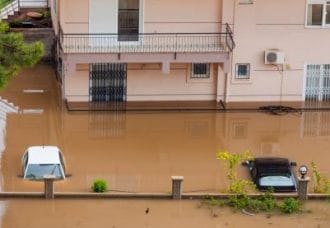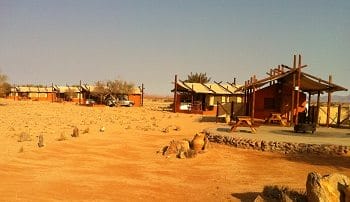
Wasp sting reactions in Alaska, wildfire pollution, unprecedented mold levels and robust ragweed simply everywhere. Our increasingly warm Earth is a giant hothouse for allergy and asthma triggers that are evolving and expanding. Acting on global warming will not only save our planet – it will spare human health.
In 2006, two men in Fairbanks, Alaska died of anaphylaxis after being stung by yellow jacket wasps. It was the first time anyone had died from an allergic reaction to an insect sting in Fairbanks, let alone two people. That year had already been a particularly bad one for yellow jackets: there were 10 times more wasps than normal, causing school outings to be canceled.
“The sudden abundance of wasps represented an increase in the survivability of the queens over the winter,” explains Dr. Jeffrey Demain, the director of the Allergy, Asthma & Immunology Center of Alaska. He wondered: could global warming be responsible for all these wasps and ultimately, the deaths?
Stinging Insect Reactions Up in Alaska
Demain began studying data from his own clinic, the local hospital’s emergency room visits, and the state’s Medicaid program database. He found increases in the number of people seeking medical attention for insect stings in all three databases. When he looked at the Medicaid database broken down by region, he found significant increases in the number of people seeking care for insect stings in all but one region: the gulf coast.
“We then started looking at climate-related variables. And what seemed to fit very closely with this puzzle was a change in temperature,” says Demain.
The five regions that saw many more patients looking for medical attention for insect stings also had at least a 6.1 degree Fahrenheit increase in winter minimal temperature over the past 50 years; the gulf region only had a 1.5 degree increase. And it turns out the gulf coast also already had the highest number of stings per capita and the highest temperature. It was the proof he needed to put the blame squarely on his state’s rising temperatures.
There are plenty of ways in which a warmer Earth can affect allergies and asthma. Allergenic insects move farther afield and thrive in suddenly hospitable climes; CO2, the gas primarily to blame for heating up the atmosphere, causes weeds to flourish and boosts pollen counts in longer growing seasons. Ground level pollution gets worse on hot days, making it difficult for asthmatics to breathe. Not to mention wild swings in weather patterns leading to drought and wildfires in some places, and floods and mold in others.
“All of these are going to affect air quality in ways that can be synergistic and may be contributing to this tremendous increase in allergies and asthma that we’re seeing,” says Dr. Paul Epstein, associate director of the Center for Health and the Global Environment at the Harvard Medical School in Boston.
Dr. Gina Solomon, a senior scientist at the Natural Resources Defense Council and a doctor of internal medicine in San Francisco, notes that “climate change is overall going to have a substantial adverse impact on allergies and asthma. But it will tend to be gradual, and affect different areas differently.”
Evidence of that is already in. From Alaska to Europe, Louisiana to British Columbia, scientists are discovering ways in which climate change is giving our allergy-causing foes a boost. The question is: are we ready to confront these effects of climate change?
Pollen Proliferation and Earlier Allergies

Ragweed is thriving with longer growing seasons.
People who say they are feeling hay fever symptoms sooner in the year and sneezing longer than they used to may be feeling first-hand the effects of global warming. “In the U.S., we’re seeing an early arrival [of spring] of about one week, and persistence of fall another week,” says Epstein. “We see this measured in the flowering of plants and the arrival of birds, and how the trees are responding to the climate.”
An early spring and a late autumn can affect when pollens peak. Dr. Donald Stark, a Vancouver allergist, has been monitoring the pollen counts of trees in his city for more than a decade. In spring, “there has been a two-week shift earlier over 13 years,” he says.
Warmer temperatures in some areas also allow new plants and trees to flourish. Ragweed, which is a fairly recent arrival to Europe, is now a major health concern as it moves into more northern countries on that continent. A study from the Global Allergy and Asthma European Network found that Hungarians are the most affected by ragweed, with about 60 per cent of people there sensitized to the weed. In Denmark, 20 per cent test positive to it.
But it is the north of the northern hemisphere where the consequences of climate change are most dramatic. “Our temperature change in Alaska is four times that of the global average,” says Demain, who is an adviser to the governor’s sub-cabinet on climate change. “We’re seeing impacts now that others are predicted to see [in the future].”
Simulations performed by the University of Alaska Fairbanks foresee a shift from a forest dominated by conifers to one in which deciduous trees are twice as prevalent as conifers by 2050. “It’s also projected that 90 per cent of the historic tundra in Alaska, over the next century, will be forested because of melting permafrost,” says Demain.
“We’re going to start sustaining an ecosystem that’s going to support trees and grasslands that’s not there now.” In Canada’s northern territories, scientists have observed the tree line moving to higher altitudes and farther north. As the world warms up, the flora is changing and people are introduced to allergens not before seen in their environment.
Compound Pollution: Ozone Assists Pollen

Smog is driving more people with asthma to emergency rooms.
Pollution, as we all know, has repeatedly been shown to be the driver of climate change. Carbon dioxide emissions from automobiles, factories and power plants get trapped in the upper atmosphere, not allowing heat to escape. Pollution from those same sources, on the ground level, becomes ozone (commonly called smog) when it’s struck by sunlight.
“As the temperatures warm, ozone production goes into overdrive,” says Solomon.
The worst smog days can make anyone feel ill. “Even healthy people find smog burns their chest when they breathe and cough, and can cause pain when they exercise,” says Solomon. “But people with asthma can end up in the emergency room or [admitted to] the hospital.”
It’s also become clear in recent years that ragweed grows larger and is more allergenic with higher CO2 levels. Epstein was involved in a study at Harvard where he and other researchers grew ragweed in greenhouses. They found that when CO2 levels were doubled, the plants grew thicker, taller and greener – and produced 61 per cent more pollen. (There is also recent research showing that CO2 has a similar effect on some other plants and trees, such as poison ivy and the loblolly pine.)
Solomon and her colleagues, aware that both ozone and ragweed were going to be significant players in the allergy assault from climate change, wondered: where are people going to be walloped by both? They began to map out the areas of the United States where ozone and ragweed are prominent. They discovered that people along the Atlantic seaboard, in Midwest states such as Missouri, Illinois and Indiana, in the Great Lakes region, and in southern and central California are looking at an itchy, sneeze-y, wheezy future.
“Those are the areas that will most likely have a hard time with global warming because we’re expecting that we’ll have both worse air quality and worse pollen,” she says. The forecast is for more to come since “the ozone season will get longer and the ragweed season will get longer,” explains Solomon. “The smog season and the ragweed season will increasingly overlap.”
Insects On The Move
From our urban cities, overrun with smog and ragweed, we move to the British Columbia interior, where Vancouver allergist Stark has been investigating a new allergen: the mountain pine beetle. The population of this notorious pest began exploding in 1993. Ever since, it has been ravaging B.C. forests because winter temperatures no longer dip low enough to kill off the insects.
Stark became suspicious about the beetle’s health impact when a number of people in the regular visiting clinics he offers up in Prince George began testing positive for allergies to cockroach. Because cockroaches are unheard of in north-central B.C., but pine beetles had become prevalent, Stark asked one of his patients, an entomologist, to bring him some pine beetle extract.
Sure enough, while only 7 per cent of people in the Vancouver area were sensitized to pine beetle, 32 per cent of people in the north-central part of the province were. However, the allergist gives two reasons why it’s difficult to pinpoint whether those who are sensitized have actually experienced allergy symptoms from the pine beetle. For one, pine beetles undertake a mass migration to new feeding grounds in early June, and it’s then that Stark believes people are being exposed to the allergen, because “there are literally millions of them in the air.”
But early June is also grass allergy season, so it’s been hard to tell whether people with respiratory symptoms are reacting to the beetles or to grass pollen. It’s also tough to track pine beetle symptoms because the insects move to new ground once they’ve killed all the trees in one area. So the newly sensitized are quickly no longer exposed to the allergen. Still, Stark views it as a clear example of how climate change is altering the world of allergies.
Fanning The Flames

Wild Fires can have a lasting effect on asthmatics.
While the pine beetle destroys forests on North America’s west coast and causes allergy sensitization, wildfires are another hazard in the trees wreaking havoc on people’s lungs around the world. As our planet experiences dramatic oscillations in weather patterns, with severe cycles of drenching and drought, there is a greater propensity for fires.
In recent years, intense blazes in California, Australia, Southeast Asia and the Amazon have had some scientists pointing the finger yet again at climate change.
“Instead of having our nice winter rain season, here in California and the Southwestern U.S., we’re tending to have drenching rain that brings mudslides and floods, followed by periods of pretty serious drought,” says Solomon. “When it gets dry toward the end of the summer, and there is no moisture left in the ground and all of the ground vegetation dies, it’s just tinder waiting to go up in flames.”
For people with asthma, smoke from fires can be a powerful trigger for symptoms. So it’s not surprising that where there’s uncontrolled burning, asthma soon follows. During worsening wildfire seasons in California, hospitals are seeing spikes in admissions because of asthma attacks. But Solomon notes that smoke brings soot that affects air quality, not just locally, but for hundreds of miles.
Epstein sees the fires as “one of the most worrisome parts of the whole picture. It’s air quality, but also, our oxygen comes from the forest.”
Mold’s Hold After Hurricane Katrina

Hurricane Katrina swamped homes in 2005.
As some areas of the world experience extreme drought and intense wildfires, other areas are seeing heavy rains, flooding, and at times, deadly storms such as hurricanes. The water that is left from these weather systems creates a hotbed for mold growth, which thrives in moist environments. “’Floods foster fungi’ is sort of a mantra in our field,” says Epstein.
After the floodwaters of Hurricane Katrina ravaged New Orleans in 2005, the city was overrun with mold. The spores turned up on walls, furniture, rugs and linens. Solomon witnessed the phenomenon when she visited the city to perform an environmental assessment.
“The thing that was stunning in New Orleans after the flood was the amount of mold that was growing on every possible surface,” she says. It was no better outside: the outdoor air in flooded areas had average daily mold counts of over 50,000 spores per cubic meter, considered “very high” by the American Academy of Allergy, Asthma & Immunology.
In addition to mold, there was another hazard to contend with: bacteria-produced endotoxins, which have been linked to increased asthma risk, says Dr. Floyd Malveaux, executive director of the Merck Childhood Asthma Network in Washington. MCAN partially funded a unique asthma study in post-Katrina New Orleans called Head-off Environmental Asthma in Louisiana (HEAL). The HEAL study was designed because New Orleans presented singular circumstances to assess how being exposed to high amounts of mold and endotoxins would affect asthma symptoms, and the development of asthma in those who are susceptible.
The researchers discovered about 70 per cent of children in New Orleans with asthma were sensitized to mold spores because of the significant exposure. “That’s much higher than we have seen in any other cities that we have studied,” says Malveaux, adding that in most inner-cities, mold sensitization is between 25 and 50 per cent.
Malveaux says another aspect of the HEAL project made a large impact: the creation of a program to help affected children manage their asthma after the flood. “The health-care system in New Orleans was severely disrupted. Many physicians left, the clinics were flooded, the records of children were destroyed, hospitals were flooded,” he says.
Kids in the HEAL study were given access to asthma counselors, assistance with accessing medical care, and aid in identifying and getting rid of moisture and mold. “There’s been a reduction in terms of asthma symptoms of those kids, more school attendance and there have been fewer emergency room visits because of that,” says Malveaux.
“We’re trying to learn lessons so that in the event. anything like this occurs again, we will be able to predict some of the things that will happen, especially for children who have asthma,” he says.
It’s this public health preparedness that Solomon says is a crucial aspect of managing allergies with respect to climate change. “It can seem rather grim,” she notes, “as any allergy sufferer does have a more uncomfortable future to look forward to. But it can be managed as long as the public health system and health-care providers and patients are all working together to make sure we’re ready with strategies to control allergies and symptoms.”
In the meantime, the prospect of a more allergic planet is another pressing reason to work on slowing the effects of climate change. “This human health issue is telling us that we’ve got to bring down carbon dioxide,” says Epstein. Whether it’s taking your bike or the bus to work, investing in a good old-fashioned push mower or reducing the setting on your air conditioner a few degrees, there are ways we can all help to lessen this allergic onslaught.
© Copyright AGW Media Inc.
Related Reading:
All About Ragweed Allergy
Pollen Allergies: The Trees of Sneeze





